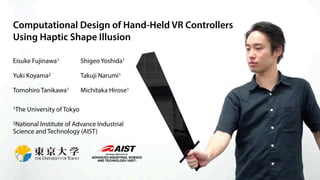
[VRST 2017] Computational Design of Hand-Held VR Controllers Using Haptic Shape Illusion
- 1. Eisuke Fujinawa1 Yuki Koyama2 Tomohiro Tanikawa1 Shigeo Yoshida1 Takuji Narumi1 Michitaka Hirose1 1The University of Tokyo 2National Institute of Advance Industrial Science and Technology (AIST) Computational Design of Hand-Held VR Controllers Using Haptic Shape Illusion
- 2. Motivation
- 3. Hand-Held VR Controllers Oculus Touch Playstation Move Tennis Racket Weapon https://www.oculus.com/rift/ https://www.playstation.com/en-us/ https://www.ea.com/en-gb/games/starwars/battlefront/battlefront-2 http://www.vrunicorns.com/selfietennis/
- 4. ‣ cannot provide proper haptic perception ‣ leads to lack of immersion inappropriate object handling Typical Controllers
- 5. ‣may not fit into limited room space ‣can be dangerous against surrounding people Naively Designed Controllers
- 6. Previous Work: Nonlinearity of Human Haptic Perception Force direction [Amemiya et al. 2005] Haptic Perception Stimulus Perception is nonlinear to Stimulus
- 7. Previous Work: Shape Perception Through Haptic Cue Shape Perception [Tuvey et al. 1996] Haptic shape perception consists of moments the moment of inertia I = ∫ mr2
- 8. New Concept: Haptic Shape Illusion
- 9. Target VR Controller A hand-held VR controller that ‣gives haptic shape perception of VR object ‣is smaller than visualized ‣is customized for each VR application ‣is limited to thin symmetric planar for simplicity
- 11. Our Approach
- 12. Shape Perception Model f : (moments) → (perceived length,width) moments perceived shape f -1: (perceived length,width) → (moments)
- 13. Data Driven Approach [Lau et al. 2016][Umetani et al. 2014] Physical Property Shape Semantics We take data-driven approach to predict shape perception model
- 14. Construction of Shape Perception Model f : (moments) → (perceived length,width)
- 15. Designing Controller Using Shape Perception Model E = || (perceived length,width) - (target length,width) ||2 E = || f (moments) - (target length,width) ||2 f : (moments) → (perceived length,width) Shap ? Prop3Prop2Prop 1 Shape Mass Prop target shape we want.. perceived shape (controller) ≒ target shape (VR) Shape3Shape2Shape1 Mass Prop controller perceived shape
- 16. Overview of Our Approach
- 17. Contribution (1) a novel design concept that uses a haptic shape illusion (2) a data-driven representation of a perceived shape based on the mass properties of a wielded object (3) an interactive optimization-guided hand-held VR controller design tool
- 18. Data Collection & Regression for Shape Perception Model
- 19. Overview of Data Collection Experiment sample controllers (w/ various moments) perceived shape (length/width) wield and estimate in VR
- 21. Condition of Experiment controllers (moments) 16 (x 4 times each) participants 10 perceived shape 640= we obtained 640 evaluation data pairs (moments, perceived shape) x
- 22. Regression of Shape Perception Model Linear Regression Quadratic Regression Gaussian Process Regression Error in L [mm] 117.5 116 115.9 Error in W [mm] 99.2 98.5 97.9 we use linear regression model for simplicity
- 23. User Study
- 24. test controllers C1 C2 C3 C4 C5 perceived shapes S1 S2 S3 S4 S5 Overview of User Study look all same in VR find most suitable one
- 25. Participant's view in VRComparing controllers controller looks the same
- 27. Design System
- 28. Target virtual model size constraint handle 1.Deformation 2.Weight Placement Optimization 3.Inner Carving Optimization CAD data of designed VR controller Overview of Design System
- 29. 1. Deformation
- 30. Target virtual model size constraint handle Deformation Weight Carving CAD data of designed VR controller Optimization of Perceived Shape Target Shape (target length,width) Current Perceived Shape f (moments) Target virtual model size constraint handle Deformation Weight Carving E = argmin || f (moments) - (target length,width) ||2 minimization for moments of the controller model
- 31. Optimization of moments moments of inertia [Beacher et al. 2012] center of gravity [Prevost et al. 2012] optimize moments of 3d model by weight placement and inner carving Target virtual model size constraint handle Deformation Weight Carving CAD V
- 32. 2. Weight Placement Optimization cf. [Baecher et al. 2012] [Prevost et al. 2012]
- 33. 3. Inner Carving Optimization
- 34. Target virtual model size constraint handle 1.Deformation 2.Weight Placement Optimization 3.Inner Carving Optimization CAD data of designed VR controller Overview of Design System
- 35. Fabrication
- 38. Sword Target shape Designed controller Target shape Designed controller Example #1 Sword
- 39. Example #1 Sword weights are gathered on the tip to represent long shape
- 41. Example #2 Tennis Racket Target shape Designed controller
- 42. Example #2 Tennis Racket weights are distributed to represent wide shape
- 44. Example #3 Electric Guitar Target shape Designed controller
- 45. Example #3 Electric Guitar handle is specified on the neck while the head is preserved
- 47. 55% size of original in average 57.7% 55.0%51.6%
- 48. Limitation & Future work
- 49. Limitation & Future Work Limited to symmetric 2D planner → Extension to 3d objects Ignored air resistance and deflectance → Incorporating into perception model Cannot represent multiple shapes →Dynamic Shape Change Weight movable device [Zenner et al. 2017]
- 50. Summary
- 51. Computational Design of Hand-Held VR Controllers Using Haptic Shape Illusion ‣a novel design concept using Haptic Shape Illusion users perceive as if they handle the object though the actual appearance of the controller differs from that of the object in VR ‣a data-driven representation of a perceived shape based on the moments of a wielded object we aggregate perceived shape data against hand-held VR controllers with different mass properties through experiments and derive the mapping using regression techniques. ‣an interactive optimization-guided hand-held VR controller design tool we implement a design system which enables automatic design of hand-held VR controllers which are smaller than target shapes while maintaining their haptic shape perception.
